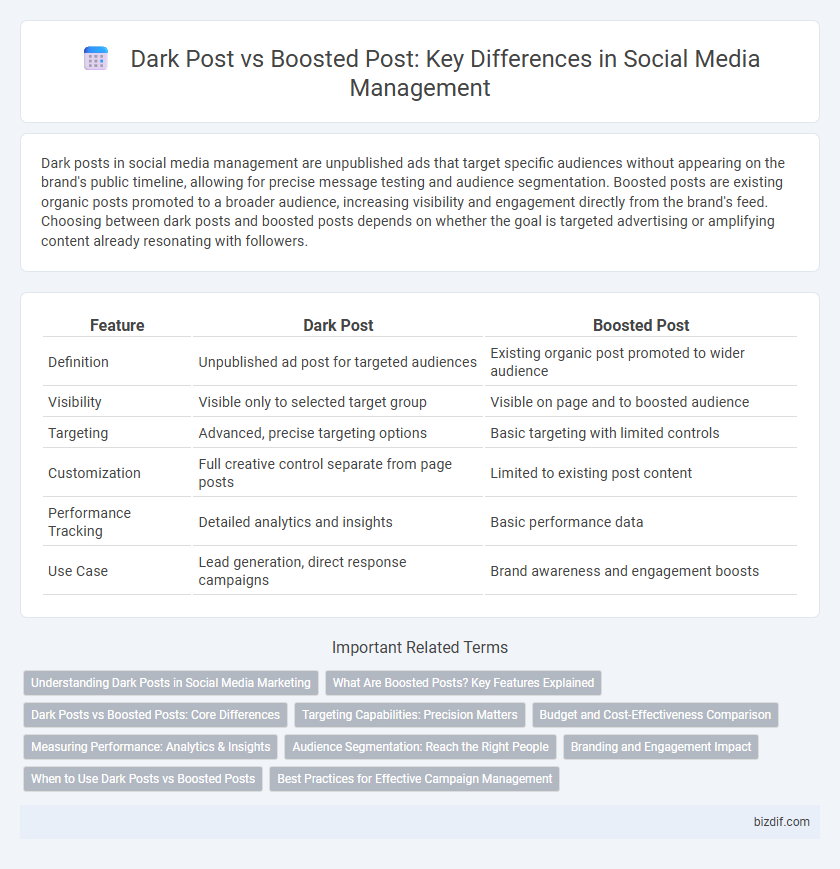Dark posts in social media management are unpublished ads that target specific audiences without appearing on the brand's public timeline, allowing for precise message testing and audience segmentation. Boosted posts are existing organic posts promoted to a broader audience, increasing visibility and engagement directly from the brand's feed. Choosing between dark posts and boosted posts depends on whether the goal is targeted advertising or amplifying content already resonating with followers.
Table of Comparison
| Feature | Dark Post | Boosted Post |
|---|---|---|
| Definition | Unpublished ad post for targeted audiences | Existing organic post promoted to wider audience |
| Visibility | Visible only to selected target group | Visible on page and to boosted audience |
| Targeting | Advanced, precise targeting options | Basic targeting with limited controls |
| Customization | Full creative control separate from page posts | Limited to existing post content |
| Performance Tracking | Detailed analytics and insights | Basic performance data |
| Use Case | Lead generation, direct response campaigns | Brand awareness and engagement boosts |
Understanding Dark Posts in Social Media Marketing
Dark posts in social media marketing refer to unpublished ads that do not appear on a business's public timeline but are targeted to specific audiences, enhancing precision and testing capabilities. Unlike boosted posts, which are organic posts promoted to reach a broader audience, dark posts enable marketers to create multiple ad variations without cluttering the main profile feed. Leveraging dark posts allows for optimized campaign performance through granular audience targeting and tailored messaging in platforms like Facebook and Instagram.
What Are Boosted Posts? Key Features Explained
Boosted posts are paid promotions on social media platforms that increase the visibility of existing organic content by targeting a specific audience based on demographics, interests, and behaviors. These posts offer simple setup options, flexible budgeting, and quick audience engagement, making them ideal for amplifying reach without creating new ads from scratch. Key features include easy-to-use targeting tools, performance tracking through insights, and the ability to choose the duration and amount of the promotion.
Dark Posts vs Boosted Posts: Core Differences
Dark posts are unpublished social media ads targeting specific audience segments without appearing on the brand's timeline, allowing precise demographic and interest-based customization. Boosted posts are existing organic posts promoted to increase visibility and engagement, typically leveraging the post's original content and social proof. The core difference lies in control and customization, with dark posts offering advanced targeting and ad creation flexibility, while boosted posts provide simpler amplification of existing content.
Targeting Capabilities: Precision Matters
Dark posts offer unparalleled targeting capabilities by enabling advertisers to create highly specific audience segments without cluttering their main social media feed, allowing precise message delivery to niche groups based on demographics, interests, and behaviors. Boosted posts provide broader reach by promoting existing content to a wider audience but lack the advanced segmentation and customization options available in dark posts. For campaigns prioritizing precision and tailored engagement, dark posts deliver superior targeting flexibility and effectiveness.
Budget and Cost-Effectiveness Comparison
Dark posts provide greater budget control by allowing precise targeting without appearing on the brand's timeline, reducing wasted ad spend and enhancing cost-effectiveness. Boosted posts have a lower entry cost but often result in broader, less optimized audience reach, potentially increasing overall expenses with less efficient conversions. Marketers achieve better ROI by allocating budgets to dark posts due to their superior targeting capabilities and minimized audience overlap.
Measuring Performance: Analytics & Insights
Dark posts provide granular control over targeting and A/B testing, enabling precise measurement of engagement metrics without cluttering the main page feed. Boosted posts offer straightforward analytics through platform-native insights, facilitating quick assessment of reach and interaction with minimal setup. Leveraging dark posts yields deeper performance analytics by isolating variables, whereas boosted posts simplify the evaluation process for broader audience impact.
Audience Segmentation: Reach the Right People
Dark posts enable precise audience segmentation by creating unpublished ads visible only to targeted groups, maximizing relevance without cluttering timelines. Boosted posts offer broader reach but limit customization in audience targeting, often leading to less efficient engagement. Utilizing dark posts enhances social media management by delivering tailored content to specific demographics based on interests, behaviors, and location data.
Branding and Engagement Impact
Dark posts allow brands to target specific audience segments without overwhelming the main social feed, enhancing personalized engagement and brand relevance. Boosted posts increase visibility among a broader audience, driving immediate engagement but often at the cost of audience fatigue on the primary page. Strategic use of dark posts supports sustained branding efforts by delivering tailored content, while boosted posts excel in short-term engagement spikes.
When to Use Dark Posts vs Boosted Posts
Dark posts are ideal for highly targeted campaigns requiring A/B testing or multiple audience segments without cluttering your timeline. Boosted posts work best for quick engagement with existing followers and expanding reach through easy-to-manage, budget-friendly promotions. Use dark posts for tailored messaging and boosted posts to amplify organic content efficiently.
Best Practices for Effective Campaign Management
Dark posts enable targeted audience segmentation by creating unpublished content tailored to specific demographics, optimizing engagement without cluttering the brand's main feed. Boosted posts increase visibility by promoting existing organic content to a broader audience, ideal for enhancing reach quickly with minimal setup. Combining dark posts with precise audience insights and continuous performance tracking ensures more efficient ad spend and higher ROI in social media campaign management.
dark post vs boosted post Infographic

 bizdif.com
bizdif.com